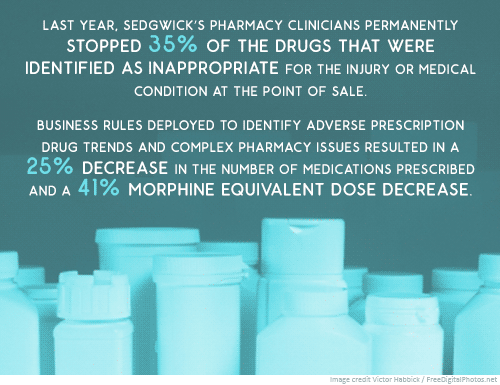
The wheels are slowly turning across the nation as state workers’ compensation regulatory agencies and state legislators focus on how to best respond to the prescription drug abuse epidemic and gain more control. Implementing a closed formulary is a strategy that has successfully reduced harmful and costly prescription drug use in Ohio, Texas and Washington state. This type of formulary, which was introduced in Washington in 2004 and in Ohio and Texas in 2011, limits drugs dispensed in workers’ compensation claims to specific lists based on medical guidelines.
Arkansas, California and Tennessee are now developing regulatory changes to try to introduce closed formularies. Results in Texas and Ohio prove that the introduction of a closed formulary changes prescribing behavior, and it significantly reduces the number of life-threatening and disability-extending prescription medications that are dispensed.
All of this begs the question: Why should employers and insurers wait for government intervention to address what is described as a national epidemic? They should not.
Employers need to ensure that claims and healthcare management administrators provide solutions to systematically manage prescription drugs at the point of sale and rebalance long-term claims demonstrating problematic drug use. This begins with the use of business rules that route claims triggered for review to specially trained pharmacy clinicians. The clinical review should provide evidenced-based decisions regarding the use of inappropriate drugs and potentially life-threatening drug combinations. This process removes the uncertainty for claims adjusters, and offers educational communication for injured employees and their physicians.
In addition, employers should review their claims and pharmacy management programs to make sure they provide routing mechanisms for appropriate intervention at the point of sale, and a consistent process for complex claims with chronic drug use or health safety threats. Analysis for rules development should focus on drug strength and appropriateness for the injury, length of prescription, prescribers involved and interaction with other prescription drugs. Compound medications must also be electronically routed for review by a clinician when they are dispensed. Alerting and engaging clinicians when compound medication activity occurs allows for targeted interventions, which can prevent long-term use and reduce drug costs. This process also helps protect the health of employees with workplace injuries and illnesses and supports a safer, faster return to work.
The outcome is simple. Claims adjusters should act as the decision-makers for prescriptions when claim compensability or relatedness is in question; and clinicians should intervene when the dosage, use, strength or associated prescribing practices are identified as potential problems.
Last year, Sedgwick’s pharmacy clinicians permanently stopped 35% of the drugs that were identified as inappropriate for the injury or medical condition at the point of sale. At the same time, the business rules deployed to identify adverse prescription drug trends and complex pharmacy issues resulted in a 25% decrease in the number of medications prescribed and a 41% morphine equivalent dose decrease.
It is good that state regulators are increasingly focusing on the prescription drug epidemic, but employers need to act now. Protect your employees and reduce pharmacy costs by making sure your claims administrator has systematic solutions in place to control the medications being prescribed within your workers’ compensation program.
Would you like to add a comment on the benefits of a closed formulary? Share your thoughts with us.
James Harvey, SVP, Managed Care Products & Product Development